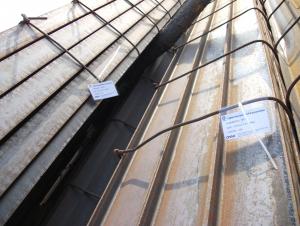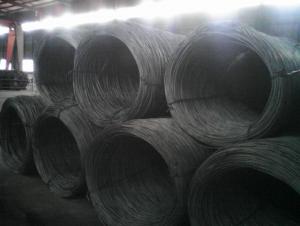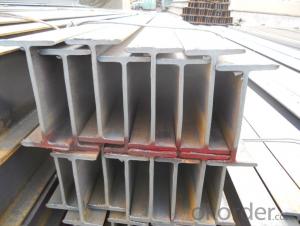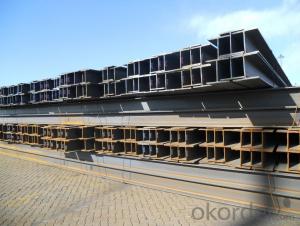JIS Standard SS400 H beams with High Quality 194mm-200mm
- Loading Port:
- China main port
- Payment Terms:
- TT or LC
- Min Order Qty:
- 100 m.t
- Supply Capability:
- 15000 m.t/month
OKorder Service Pledge
OKorder Financial Service
You Might Also Like
Specifications of JIS Standard SS400 H beams with High Quality 194mm-200mm:
1. Standard: JIS 3192
2. Grade: SS400 or Equivalent
3. Length: 10m, 12m as following table
4. Invoicing on theoretical weight or actual weight as customer request
5.Payment: TT or L/C
Size and Mass of JIS Standard SS400 H beams with High Quality 194mm-200mm:
| Size (mm) | Mass (Kg/m) | Size (mm) | Mass (Kg) |
| 198*99*4.5 | 17.8 | 194*150*6 | 29.9 |
| 200*100*5.5 | 20.9 | 200*200*8 | 49.9 |
Packaging & Delivery of JIS Standard SS400 H beams with High Quality 194mm-200mm for Building Structures:
1. Packing: it is nude packed in bundles by steel wire rod
2. Bundle weight: not more than 3.5MT for bulk vessel; less than 3 MT for container load
3. Marks:
Color marking: There will be color marking on both end of the bundle for the cargo delivered by bulk vessel. That makes it easily to distinguish at the destination port.
Tag mark: there will be tag mark tied up on the bundles. The information usually including supplier logo and name, product name, made in China, shipping marks and other information request by the customer.
If loading by container the marking is not needed, but we will prepare it as customer request.
4. Transportation: the goods are delivered by truck from mill to loading port, the maximum quantity can be loaded is around 40MTs by each truck. If the order quantity cannot reach the full truck loaded, the transportation cost per ton will be little higher than full load.
5. Delivered by container or bulk vessel
FAQ:
Q1: Why buy Materials & Equipment from OKorder.com?
A1: All products offered by OKorder.com are carefully selected from China's most reliable manufacturing enterprises. Through its ISO certifications, OKorder.com adheres to the highest standards and a commitment to supply chain safety and customer satisfaction.
Q2: How do we guarantee the quality of our products?
A2: We have established an advanced quality management system which conducts strict quality tests at every step, from raw materials to the final product. At the same time, we provide extensive follow-up service assurances as required.
Q3: How soon can we receive the product after purchase?
A3: Within three days of placing an order, we will arrange production. The shipping date is dependent upon the quatity, how many sizes you want and the plan of production, but is typically 1 month to 2 months days from the beginning of production.
Images of JIS Standard SS400 H beams with High Quality 194mm-200mm:


* If you would like to get our price, please inform us the size, standard/material and quantity. Thank you very much for your attention.
- Q: What are the environmental impacts of steel H-beams?
- Steel H-beams have several environmental impacts, including the extraction and processing of raw materials, such as iron ore and coal, which contribute to air and water pollution. The manufacturing process also requires a significant amount of energy, resulting in greenhouse gas emissions. Additionally, the transportation and installation of steel H-beams contribute to carbon emissions. However, steel H-beams are durable and long-lasting, which can offset some of their environmental impacts by reducing the need for frequent replacements.
- Q: What are the different surface finishes available for steel H-beams?
- Steel H-beams come in various surface finishes, each with its own unique properties and advantages. Some commonly used surface finishes for steel H-beams include: 1. Mill finish: This is the standard finish straight from the steel mill. It has a slightly rough texture and may have minor imperfections. Mill finish is typically used for structural applications where appearance is not a priority. 2. Hot-dip galvanized: In this finish, the steel H-beam is immersed in molten zinc, creating a protective layer that prevents corrosion. Hot-dip galvanizing is commonly used for outdoor structures or applications exposed to harsh environments. 3. Painted: Steel H-beams can be coated with paint for both aesthetic and protective purposes. Painted finishes offer a wide range of color options and provide additional corrosion resistance. 4. Powder-coated: Powder coating is a durable and attractive finish applied electrostatically as a dry powder and cured under heat. It is resistant to chipping, scratching, and fading. 5. Primed: Priming involves applying a layer of primer to the steel H-beam before any additional finish is applied. Primers enhance adhesion of subsequent coatings and provide an extra layer of protection against corrosion. 6. Stainless steel: Instead of surface finishes, stainless steel H-beams are often left with a natural finish due to their inherent resistance to corrosion. The stainless steel material itself offers excellent durability and resistance to staining or rusting. When selecting a surface finish for steel H-beams, it is important to consider the specific application and environment. Factors such as durability, corrosion resistance, appearance, and cost will all influence the most suitable finish. Seeking guidance from a steel supplier or specialist can ensure the best choice for your specific needs.
- Q: Can steel H-beams be used in the construction of data centers?
- Yes, steel H-beams can be used in the construction of data centers. Steel H-beams are commonly used in construction due to their strength and durability. They provide excellent support for heavy loads and can withstand the weight of equipment and infrastructure required in data centers. Additionally, steel H-beams are versatile and can be easily customized to meet the specific needs and design requirements of a data center. They are also fire-resistant, which is crucial for data centers to ensure the safety and protection of valuable data and equipment. Overall, steel H-beams are a reliable and ideal choice for construction in data centers.
- Q: Can steel H-beams be used for exhibition halls?
- Yes, steel H-beams can be used for exhibition halls. Steel H-beams are commonly used in construction projects due to their strength and versatility. They provide excellent structural support and can withstand heavy loads and stress, making them suitable for large-scale structures such as exhibition halls. Additionally, steel H-beams can be easily fabricated and assembled, allowing for efficient construction. They also have a long lifespan and require minimal maintenance, making them a cost-effective choice for exhibition hall projects.
- Q: What are the common design mistakes to avoid when using steel H-beams?
- When using steel H-beams in design, there are several common mistakes that should be avoided to ensure structural integrity and safety. These mistakes include: 1. Inadequate beam sizing: One common mistake is selecting an H-beam size that is too small for the intended load. This can result in structural failure or excessive deflection. It is crucial to accurately calculate the required beam size based on the expected loads and consult structural engineering guidelines or professionals for proper sizing. 2. Incorrect placement of beams: Ensure that H-beams are properly placed and aligned. Misalignment or incorrect spacing can compromise the load-bearing capacity and stability of the structure. It is important to follow the structural design plans and guidelines to ensure correct placement. 3. Insufficient connection strength: Another mistake is using improper or inadequate connections between H-beams and other structural elements. Inadequate connection strength can lead to failure or inadequate load transfer. Proper connection design, such as welding or bolted connections, should be employed to ensure structural integrity. 4. Lack of bracing: Failing to provide sufficient bracing for H-beams can result in excessive deflection and instability. Bracing helps to resist lateral loads and prevent buckling of the beams. It is important to carefully consider the bracing requirements and incorporate them into the design to ensure stability. 5. Neglecting corrosion protection: Steel H-beams are susceptible to corrosion, especially in environments with high moisture or aggressive chemicals. Neglecting proper corrosion protection measures can lead to premature deterioration and compromise the structural integrity of the beams. Coatings, such as paint or galvanization, should be applied to protect the steel from corrosion. 6. Ignoring thermal expansion: Steel H-beams can expand and contract with temperature changes. Ignoring the thermal expansion and not providing sufficient allowances for movement can result in stress accumulation and potential failure. Proper consideration of thermal expansion and contraction should be incorporated into the design to prevent structural problems. To avoid these common design mistakes, it is crucial to consult structural engineering guidelines, codes, and professionals, who can provide accurate calculations, proper sizing, and guidance for the specific project requirements.
- Q: Can Steel H-Beams be recycled or reused?
- Yes, Steel H-Beams can be recycled and reused. Steel is one of the most recycled materials in the world, and H-Beams are no exception. When H-Beams are no longer needed, they can be collected and taken to recycling centers or scrap yards. The beams are then melted down and transformed into new steel products. Recycling H-Beams reduces the demand for raw materials and helps to conserve energy and resources. Additionally, if the H-Beams are still in good condition, they can be reused in construction projects, providing cost-effective and sustainable solutions. Overall, the ability to recycle and reuse Steel H-Beams contributes to a more environmentally friendly and sustainable construction industry.
- Q: How do you protect steel H-beams from corrosion?
- There are multiple effective techniques available to safeguard steel H-beams against corrosion. One commonly used method involves the application of a protective coating or paint onto the beams' surface. This coating acts as a barrier, preventing moisture and other corrosive agents from coming into contact with the H-beams. It is crucial to ensure that the coating is applied evenly and thoroughly on all surfaces of the beams, including the ends and any exposed edges. Another approach is to galvanize the steel H-beams. Galvanization entails coating the steel with a layer of zinc, which provides excellent corrosion resistance. The zinc coating acts as a sacrificial layer, meaning it corrodes before the steel, thereby prolonging the H-beams' lifespan. Galvanization can be achieved through hot-dip galvanizing, where the H-beams are immersed in molten zinc, or through electro-galvanizing, which involves applying a zinc coating via an electrochemical process. Regular maintenance is also vital to protect steel H-beams against corrosion. This involves inspecting the beams for any signs of damage or rust and promptly addressing any issues. It is important to remove loose rust or scale from the beam's surface using wire brushes or abrasive pads and then apply a suitable primer or coating to prevent further corrosion in affected areas. Furthermore, ensuring proper drainage around the H-beams is crucial in preventing corrosion. The accumulation of standing water or moisture can contribute to the corrosion process. Therefore, it is essential to design and construct structures in a way that facilitates effective water drainage. Additionally, avoiding contact with other materials that may accelerate corrosion, such as certain chemicals or incompatible metals, is important in protecting the steel H-beams. In conclusion, safeguarding steel H-beams from corrosion involves a combination of preventive measures, including coating application and galvanization, regular maintenance, and proper design and construction practices. By implementing these strategies, the lifespan of steel H-beams can significantly increase, ensuring their structural integrity and durability.
- Q: Can steel H-beams be used in industrial buildings?
- Yes, steel H-beams are commonly used in industrial buildings due to their strength, durability, and versatility. They provide excellent structural support and can withstand heavy loads, making them ideal for large-scale industrial construction projects.
- Q: Are steel H-beams suitable for stadium construction?
- Yes, steel H-beams are commonly used in stadium construction due to their high strength-to-weight ratio, durability, and ability to support heavy loads. They provide structural stability, allowing for large open spaces and flexible designs, making them an ideal choice for stadium construction.
- Q: Can Steel H-Beams be used in agricultural or barn construction?
- Yes, Steel H-Beams can be used in agricultural or barn construction. They are commonly used in such applications due to their strength, durability, and structural stability. Steel H-Beams provide excellent support for large open spaces, making them suitable for barns and other agricultural buildings where wide spans are required. Additionally, steel beams are resistant to pests, fire, and weather conditions, making them a reliable choice for agricultural construction projects.
Send your message to us
JIS Standard SS400 H beams with High Quality 194mm-200mm
- Loading Port:
- China main port
- Payment Terms:
- TT or LC
- Min Order Qty:
- 100 m.t
- Supply Capability:
- 15000 m.t/month
OKorder Service Pledge
OKorder Financial Service
Similar products
Hot products
Hot Searches
Related keywords




























